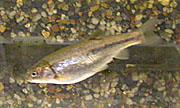Arroyo chub
This article includes a list of general references, but it lacks sufficient corresponding inline citations. (November 2018) |
| Arroyo chub | |
|---|---|

| |
| Scientific classification | |
| Domain: | Eukaryota |
| Kingdom: | Animalia |
| Phylum: | Chordata |
| Class: | Actinopterygii |
| Order: | Cypriniformes |
| Family: | Cyprinidae |
| Genus: | Gila |
| Species: | G. orcuttii
|
| Binomial name | |
| Gila orcuttii C. H. Eigenmann & R. S. Eigenmann, 1890
| |
The arroyo chub (Gila orcuttii) is a cyprinid fish found only in the coastal streams of southern California, United States.
The shape of the arroyo chub is somewhat chunky, with a deep body and thick caudal peduncle. The eyes are larger than average for cyprinids. Coloration ranges from silver to gray to olive green above, shading to white below, usually with a dull gray band along each side. The dorsal fin has 8 rays, while the rounded anal fin has 7. Males have larger fins than females, and, during the breeding season, patches of breeding tubercles on the upper surfaces of the pectoral fins. This is a small fish, with most adults in the 7–10 cm length range, and a maximum of 12 cm.
Omnivorous, their diet includes algae, insects, and crustaceans. Studies of fish from warmwater streams shows a preponderance of algae in the stomach (60-80%), and they are also known to feed on the roots of Azolla (floating water ferns). In cooler streams, molluscs and caddisfly larvae predominate in the diet.
Arroyo chub habitat is primarily the warm streams of the Los Angeles Plain, which are typically muddy torrents during the winter, and clear quiet brooks in the summer, possibly drying up in places. They are found both in slow-moving and fast-moving sections, but generally deeper than 40 cm.
They are native to Los Angeles, Santa Margarita, San Gabriel, San Luis Rey, and Santa Ana Rivers, as well as to Rainbow, Temecula, Malibu and San Juan Creeks. Many of the original populations have been extirpated, but it has recently been reestablished in the Arroyo Seco (Los Angeles County), a tributary of the Los Angeles River. It has been found in the Los Angeles River (Sepulveda Dam Basin) as recently as 1978. The species also has been successfully introduced in a number of other rivers in the area, and can be found as far north as Chorro Creek in San Luis Obispo County, and as far east as the Mojave River. The Mojave and Cuyama River populations extend into the ranges of related fishes, and hybridize with Mojave chub and California roach, respectively.
The species epithet was chosen in honor of C. R. Orcutt, who in 1889 made the first collection of this fish, improvising by using a blanket as a seine. It is often misspelled as orcutti, although this is still considered a valid synonym, and is for instance used by Moyle in his book.
References
- ^ NatureServe (2013). "Gila orcuttii". IUCN Red List of Threatened Species. 2013: e.T202107A18234591. doi:10.2305/IUCN.UK.2013-1.RLTS.T202107A18234591.en. Retrieved 18 November 2021.
- "Gila orcuttii". Integrated Taxonomic Information System. Retrieved 18 April 2006.
- Peter B. Moyle, Inland Fishes of California (University of California Press, 2002), pp. 130–131
- Froese, Rainer; Pauly, Daniel (eds.). "Gila orcuttii". FishBase. April 2006 version.
- Central Arroyo Stream Restoration Program cf: Chub in the Arroyo Seco
- IUCN Red List vulnerable species
- Chubs (fish)
- Gila (fish)
- Endemic fauna of California
- Fauna of the California chaparral and woodlands
- Fish of the Western United States
- Freshwater fish of the United States
- Natural history of Los Angeles County, California
- Natural history of the Peninsular Ranges
- Natural history of the Transverse Ranges
- Fish described in 1890

